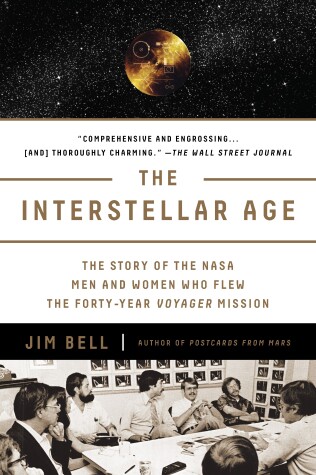
The story of the men and women who drove NASA’s Voyager spacecraft mission—the farthest-flung emissaries of planet Earth—told by a scientist who was there from the beginning.
Voyager 1 left our solar system in 2012; its sister craft, Voyager 2, did so in 2018. The fantastic journey began in 1977, before the first episode of Cosmos aired. The mission was planned as a grand tour beyond the moon; beyond Mars, Jupiter, Saturn, Uranus and Neptune; and maybe even into interstellar space. The fact that it actually happened makes this humanity’s greatest space mission.
In The Interstellar Age, award-winning planetary scientist Jim Bell reveals what drove and continues to drive the members of this extraordinary team, including Ed Stone, Voyager’s chief scientist and the one-time head of NASA’s Jet Propulsion Lab; Charley Kohlhase, an orbital dynamics engineer who helped to design many of the critical slingshot maneuvers around planets that enabled the Voyagers to travel so far; and the geologist whose Earth-bound experience would prove of little help in interpreting the strange new landscapes revealed in the Voyagers’ astoundingly clear images of moons and planets.
Speeding through space at a mind-bending eleven miles a second, Voyager 1 and Voyager 2 are now beyond our solar system’s planets, the first man-made objects to go interstellar. By the time Voyager passes its first star in about 40,000 years, the gold record on the spacecraft, containing various music and images including Chuck Berry’s “Johnny B. Goode,” will still be playable.
*An ALA Notable Book of 2015*
In The Interstellar Age, planetary scientist Jim Bell celebrates the Voyager program, which has continued far beyond the spacecrafts' initial mission.
Bell stresses the critical importance of scientific grunt work, all the stuff that happens behind the scenes of these enormous projects. No job, however small it seems, is unimportant. He points out that all types—whether "tinkerer" or a "theoretician," whether seen or unseen—are vital to the team and their success.
Something that struck me while reading: It's astonishing to think about how much data Voyager has provided (and continues to provide) using technology that is 40 years old—Voyager's computer is about a million times slower than today's laptops. It's also amazing to see just how much problem-solving is involved as the mission continues.
Amidst Voyager's story, Bell includes personal anecdotes that show his love for the space program and his respect for the people involved in the mission. These anecdotes do help keep tedium at bay, but there are still portions of the book that drag. It helps to be interested in the more technical aspects of a space mission, but I think there's enough of a balance that any reader who loves space will enjoy this.
Reading updates
-
Started reading
-
Finished reading
-
2 February, 2016:
Reviewed
